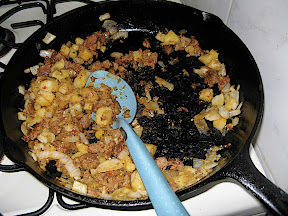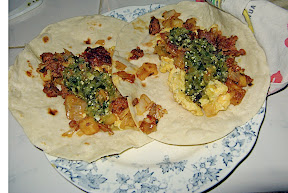
One of the lesser, but frequent challenges for the expat in Mexico is ordering eggs in a restaurant. If you are fussy about how you want them cooked, as many are, you should read the following primer about getting your eggs the way you want.
But before anything else, I want to confront head on the nearly apocryphal mysteries of the double meaning of the word, "huevos". While it's true that it also has a second meaning of "testicles", or more accurately, "balls", the visiting gringo or savvy expat should not worry about evoking snickers or even guffaws from the waitstaff. The staff deals with eggs all morning, and if they were constantly snickering, they'd have no time or energy left to serve customers. That sort of humor, and also about chiles (a potent phallic symbol) is best relegated to the humorous repertoire of small boys and barely pubescent adolescents.Common Pitfalls In Ordering Eggs
Nota bien: if you accompany your ordering with sign language, you may provoke humor. If you personalize your order, you run further risks. For example, don't say, "I'll have your eggs, fried, and over easy."
That's personalizing it. You just want "huevos estrellados."
1. "Huevos al Gusto", literally, "eggs to your pleasure", but really "eggs to order".
Don't make the mistake of a one of our visiting friends and say, "I'll have the huevos al gusto." The waiter will have to ask you again how you want them prepared.
2. "Huevos Estrellados", or eggs, sunnyside up. These are among the most popular. You need not accompany your request with elaborate sign language, making what seem to the waiter to be confusing and possibly humorous gestures. You have a better chance of getting them as you like if you use those two simple words. And, "por favor", of course.
3. "Huevos a la Mexicana": eggs scrambled with chopped chiles, tomatoes and onions. Simply, "eggs in the style of a Mexican woman". Try not to say, "huevos al MexicanO", which gives a simple order a new, special meaning.
4. "Eggs, over easy" aren't easy to order. Many restaurants don't get the concept. You have to ask for "huevos fritos volteados". I once mistakenly said, trying to be helpful to another breakfaster, "huevos revolcados", or something like, "knocked down eggs". Where did I get that?
If you are lucky, one of your breakfast companions will order eggs sunnyside up, using gestures, and his eggs will arrive
Let's move along quickly now. The following egg dishes are less fraught with peril:
5. "Huevos Rancheros": eggs sunnyside up, on top of a lightly fried tortilla or two, covered with a salsa picante. Why this is totally snigger free is a mystery.
6. "Huevos Divorciados." Sounds spicy, and they are: two eggs, estrellados, one in salsa verde and the other in salsa roja, on top of tortillas. This is a gringo favorite, especially those who have been in Santa Fe, New Mexico.
7. "Huevos revueltos": I almost forgot them! Scrambled eggs. They are seldom cooked as I like, so I do not order them while breakfasting out.
8. "Omeleta" Sounds like "omelet", and it is. Usually made with two eggs, and filled "al gusto". What does "al gusto" mean? Class???
"As you like.", that's right. Muy bien.
So, you will need to specify what you want in it. "Tocino" (bacon), "queso", (cheese); "cebolla" (onion), et cetera. Omelets are usually attractively garnished with onion, tomato and avocado, so you get a bonus for your breakfast pesos.
Special hint: The Omeleta de espárragos, cebolla, nopal y queso at the Gran Hotel Café in Pátzcuaro is a delight.
9. "Huevos Albañil", or "Stonemason's eggs"; scrambled eggs drowned in a very spicy sauce. Order this, as I do, when you want to be a cool, Old Mexico Hand.
10. Poached eggs: in general, don't even try, unless you are in the restaurant of an international hotel. My Spanish-English digital dictionary yields the word, "escalfar" for "poached", but we have had some limited success with "huevos pocheados". Don't get your hopes up. Please, whatever you do don't call them "huevos pochos".
There are other ways of preparing eggs, but the above listed are among the most commonly encountered. For further information, sign up for our advanced Huevos Clase.
Always be polite, and say "Por favor" and "gracias" at appropriate times. Try to keep gestures and especially sign language to the minimum. They look rude.
Finally, try to remember that Patience Is A Virtue, and that glitches in service do not occur only in Mexico. I'll end with a video drama, made in an American diner, to keep things in perspective.
This is probably my last post of 2008. We'll be travelling to México D.F., Puebla, and then spending a couple of weeks on Oaxaca. I hope to be observing, tasting and even cooking while we are there. With luck and energy, I'll report back on our experiences.





















